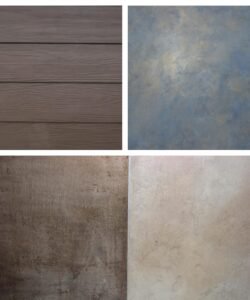Introduction to Amazing Residential Paints
Residential paints play a crucial role in enhancing the aesthetic appeal and protection of homes. This category encompasses a broad range of products designed specifically for residential applications, addressing both interior and exterior needs. The right choice of paint can significantly impact the overall ambiance of living spaces, contributing to an inviting and visually appealing environment.
The market offers a diverse array of residential paints, enabling homeowners to select options that align with their style preferences and functional requirements. Among the various types available, one can find water-based and oil-based paints, finishes ranging from matte to high gloss, and specialized formulations catering to unique conditions, such as low-VOC (volatile organic compounds) paints for environmentally conscious consumers. Each type serves a distinct purpose, thus underscoring the need for informed decision-making based on specific project requirements.
Additionally, considering elements like durability, ease of application, and maintenance can undeniably influence the choice of residential paints. For instance, Mithila paints, known for their distinct regional heritage, present homeowners with options that can enhance both the aesthetic and cultural significance of their living spaces. These paints, characterized by vibrant colors and intricate designs, offer a unique solution for those seeking to integrate traditional artistry into modern home décor.
As homeowners embark on their painting projects, understanding the foundational aspects of residential paints is essential. From color selection to understanding paint types suitable for various surfaces, knowledge of these elements will help facilitate the creation of a harmonious and protected living environment. The subsequent sections will delve deeper into individual paint types, applications, and best practices for achieving optimal results in residential settings.

Types of Residential Paints
When it comes to selecting paint for residential projects, understanding the various types available is crucial for achieving the desired finish and durability. Among the most common are latex paints, oil-based paints, and specialty paints, each boasting distinct characteristics and benefits that cater to different needs and preferences.
Latex paints, also known as water-based paints, are popular for their ease of use and quick drying times. They are made with water as the primary solvent, which makes them less toxic and easier to clean. These paints exhibit excellent color retention and are known for their ability to resist fading when exposed to sunlight. Moreover, latex paints are ideal for interior walls, ceilings, and trim, making them a go-to choice for homeowners seeking an accessible and environmentally friendly option. Their flexibility and low odor further enhance their appeal, particularly in living spaces.
On the other hand, oil-based paints offer a different set of advantages, particularly their durability and smooth finish. Composed of oil-based solvents, these paints take longer to dry, which can actually allow for better leveling and a polished look. They are highly resistant to wear and tear, making them suitable for high-traffic areas, doors, and cabinets. However, with their use comes the need for solvents for cleanup, such as mineral spirits, making them a bit less convenient for some DIY-enthusiasts.
Lastly, specialty paints cater to specific needs within residential interiors and exteriors. This category includes paints designed for unique applications, such as chalkboard paint, magnetic paint, and mildew-resistant formulations. These unique offerings not only enhance the functionality of various surfaces but also provide an opportunity for creative expression. Whether opting for the rustic charm of mithila paints or selecting a conventional choice, understanding these types ensures that homeowners can make informed decisions tailored to their individual projects.
Understanding Paint Finishes
When selecting the appropriate paint for a residential project, it is essential to understand the various finishes available, as each imparts distinct characteristics and advantages to the painted surfaces. The choice of paint finish not only influences the appearance of a room but also determines durability, maintenance requirements, and overall aesthetic appeal.
Starting with the matte finish, this type offers a non-reflective surface that is ideal for hiding imperfections on walls. While it provides a sophisticated and smooth look, the drawback is its lower durability, making it less suitable for high-traffic areas where the likelihood of scuffs and marks is increased. As a solution, mithila paints often offer a matte variant that can withstand light cleaning, thereby enhancing its functionality.
Eggshell finishes provide a subtle sheen that sits between matte and satin, making them a popular choice for living spaces. They combine the aesthetics of a matte finish with improved durability, allowing for easier cleaning and maintenance. For those looking for a wider variety of color options, mithila paints in eggshell finish can deliver vibrant hues that still maintain functionality.
Satin finishes are slightly glossier and are known for their durability, making them suitable for areas such as kitchens and bathrooms. They resist moisture and stains effectively, offering an enduring solution that requires minimal maintenance. Similarly, semi-gloss and gloss finishes are often utilized in spaces where shine is desired, such as trim and moldings. These finishes not only enhance the visual appeal but also offer high durability and easy cleaning.
In conclusion, the choice of paint finish significantly impacts both the appearance and functionality of painted walls in residential spaces. Understanding the differences among finishes, such as matte, eggshell, satin, semi-gloss, and gloss, allows homeowners to make informed choices that align with their preferences and lifestyle needs. Selecting proper finishes from brands like mithila paints ensures that the chosen aesthetic is complemented by long-lasting performance.

Choosing the Right Color Scheme
When selecting a color scheme for residential spaces, various factors must be considered, including lighting, room size, and personal style. Each of these elements contributes significantly to the overall atmosphere and aesthetic appeal of a home. It is essential to evaluate how natural and artificial light interacts with different hues, as lighting can change the perception of color. For instance, a color may appear warmer in the glow of candlelight but may seem cooler in daylight. Thus, it’s advisable to sample paint colors on walls at various times of the day to observe their true character and effect.
Room size also plays a critical role in color selection. Lighter shades tend to make spaces appear larger and more open, making them ideal for smaller rooms. Conversely, darker colors can create a cozy environment in larger spaces but may feel overwhelming if used excessively. Therefore, striking a balance is crucial, and one may consider using lighter colors as the base while incorporating darker tones in accents or furnishings.
Personal style is another key element when choosing a color scheme. It is beneficial to draw inspiration from existing decor, personal experiences, and even cultural backgrounds. For example, the vibrancy and emotional warmth of Mithila paints can be a delightful addition to a home. These vivid colors and intricate patterns evoke a sense of artistry and cultural heritage that many find appealing. Keeping color psychology in mind, warmer tones tend to evoke feelings of comfort and energy, while cooler tones often promote tranquility and relaxation. To create a harmonious palette, consider using analogous colors, which are adjacent on the color wheel, or a complementary scheme to bring balance and visual interest.
By thoughtfully considering these elements and integrating a touch of creativity, it becomes possible to select a color scheme that provides both visual appeal and emotional impact for any residential space.

Preparing Surfaces for Painting
Proper surface preparation is a critical step in the painting process that directly impacts the quality and longevity of the finish. Before applying any paint, including popular options like mithila paints, it is essential to ensure that the surfaces are clean, smooth, and free from defects. The following steps outline the key aspects of preparation.
The first step is to clean the surfaces thoroughly. Dust, dirt, grease, and grime can prevent paint from adhering properly, leading to peeling and flaking. For exterior surfaces, this may involve power washing to remove accumulated debris, while interior surfaces may require a gentle scrub with soap and water. Pay special attention to areas that collect moisture, as mildew can become an issue if not treated beforehand.
Once the surfaces are clean, inspecting them for any damage is crucial. This includes looking for cracks, holes, and imperfections. Any noticeable damage should be repaired prior to painting. For example, small holes can be filled with spackle or putty, while larger cracks may require caulking. This not only enhances appearance but also ensures a smooth finish when mithila paints or any other quality paint is applied.
After repairs are made, it is important to sand the surfaces as needed. Sanding creates a smooth texture that helps the paint adhere better. This step is particularly vital for surfaces that are glossy or previously painted. Once sanding is complete, vacuuming up the dust and debris ensures a clean canvas for the paint application.
Finally, priming the surface is often recommended, especially when transitioning from a dark color to a lighter one or when painting over bare materials. A good primer serves as a bonding agent, ensuring that subsequent coats of mithila paints adhere effectively and provide a durable finish. In conclusion, following these systematic steps for surface preparation can significantly enhance the effectiveness of your painting project, resulting in a beautiful and lasting result.

Application Techniques for Residential Paints
Choosing the right application technique is crucial for achieving a professional finish when using residential paints, including traditional options like mithila paints. The primary methods available are brushing, rolling, and spraying, each offering unique advantages based on the project and surface type.
Brushing is often favored for detailed work, especially on trim and intricate surfaces. It allows for precision and control, making it suitable for smaller areas and touch-ups. When selecting a brush, consider the type of bristles and the size of the brush head; for instance, synthetic bristles work well with latex paints, while natural bristles are ideal for oil-based paints. For beginners, it’s advisable to invest in a high-quality brush to ensure a smoother application and to avoid streaks.
Rolling is an efficient technique for covering large areas, such as walls and ceilings. It results in an even application and minimizes visible brush strokes. A roller nap thickness is essential to consider, as it varies depending on the surface texture. For smooth surfaces, a short nap is adequate, while a longer nap is necessary for rough textures. Beginners should practice maintaining a wet edge while rolling to avoid lap marks. Additionally, a roller grid or pan can help manage excess paint and ensure an efficient workflow.
Spraying is best for achieving a smooth, even coat quickly, particularly on large, flat surfaces or when aiming for a contemporary finish. However, this method requires more preparation and skill, as it can produce overspray and requires protective coverings for surrounding areas. For those new to spraying, it’s essential to select the right spray tip and maintain a consistent distance from the surface being painted. Learning how to control the spray pattern can significantly affect the overall finish.
In conclusion, understanding these application techniques will enable beginners to choose the right tools and methods for various surfaces when using residential paints, including mithila paints. Mastery of application not only enhances the aesthetic appeal but also ensures durability and longevity in residential spaces.
Safety Tips for Painting at Home
Painting your home can be an enjoyable and rewarding task, but it is crucial to prioritize safety throughout the process, whether indoors or outdoors. One of the most significant safety considerations is ensuring proper ventilation. When using paint products, especially oil-based or solvent-based paints, harmful fumes can accumulate in closed spaces. Therefore, it is essential to open windows and doors to allow fresh air circulation while painting. If working in a poorly ventilated area, consider using fans to direct airflow and reduce inhalation of toxic fumes.
In addition to ventilation, wearing appropriate protective gear is vital for safeguarding your health. A respirator or mask designed for paint fumes will help filter out harmful chemical particles. Furthermore, gloves and goggles should be worn to protect your skin and eyes from any paint splatter or irritation. It is advisable to wear clothing that you do not mind damaging, as paint can be difficult to remove from fabric. By taking these precautions, you create a safer working environment that minimizes potential health risks.
Another essential aspect of safety involves the proper disposal of paint materials. Unused or leftover paints can pose a hazard to the environment if not disposed of correctly. Many communities have specific guidelines for disposing of hazardous waste, including paint. Consider checking local waste management resources to find designated drop-off locations or scheduled collection days for hazardous materials. Alternatively, you may want to find ways to repurpose or recycle paint. By following these safety tips, you will not only ensure a safer painting experience but also contribute positively to environmental conservation.
Maintenance and Touch-Up Tips
Maintaining painted surfaces in your home is essential to preserve their appearance and longevity. Regular maintenance ensures that your walls not only look beautiful but also remain protected from wear and tear. One effective approach is to clean painted surfaces periodically. For indoor walls, a gentle dusting with a microfiber cloth will remove dust and dirt buildup. If you encounter stains, using a mild soap solution or a specialized wall cleaner can help. Always test any cleaning solution on a small, inconspicuous area to ensure it doesn’t damage the Mithila paints or change their appearance.
Touching up scuffs or scratches can be a straightforward process. Begin by ensuring you have the same color and finish of paint used during the original application. It’s advisable to store an additional can of paint from the initial job to guarantee you have an exact match for touch-ups. When applying touch-up paint, use a clean brush or roller to blend the new paint seamlessly with the existing layer. Feather the edges of the touch-up area to smooth out the transition and minimize visibility.
It may be necessary to repaint areas of your home when colors fade, or there are noticeable signs of wear, such as peeling or cracking. The frequency of repainting can depend on environmental factors, type of paint, and the location of your walls. High-traffic areas may require more frequent touch-ups or repaints. To extend the life of your Mithila paints, ensure proper ventilation in rooms, particularly kitchens and bathrooms, where moisture can cause damage. Furthermore, applying a protective topcoat in these areas can shield the paint from splatters and humidity, contributing to a longer-lasting finish.
Conclusion: Making the Right Paint Choices for Your Home
In this guide, we have explored the essential aspects of selecting the right paints for residential applications, emphasizing the crucial role that color, finish, and type of paint play in transforming any space. Choosing the appropriate paint not only enhances the aesthetic appeal of a home but also influences its longevity and maintenance requirements. From classic mitihla paints known for their intricate designs to modern formulations that offer durability and ease of application, the variety available today provides ample options for homeowners.
Safety and environmental considerations should also be paramount when selecting paints. Utilizing low-VOC or eco-friendly alternatives can create a healthier environment while minimizing harmful emissions. Additionally, understanding the surface to be painted and the specific conditions it will be subjected to—such as moisture levels or exposure to sunlight—will guide you in making informed decisions regarding the kind of paint suitable for your requirements.
Furthermore, we discussed the importance of finishes and how they can influence not only the appearance but also the functionality of the painted surface. For example, glossy finishes provide better durability and cleanability, making them excellent choices for high-traffic areas, while matte finishes can add warmth and elegance to a space.
As you plan your next painting project, consider these key points. The thoughtful selection of paints, including the artistry reflected in mithila paints or similar techniques, provides an opportunity to express personal style while enhancing the function and beauty of your living space. Engage with professionals if necessary to ensure each choice aligns with your vision. Ultimately, informed paint selections can significantly elevate your home’s ambiance, making it a place of comfort and inspiration for years to com

